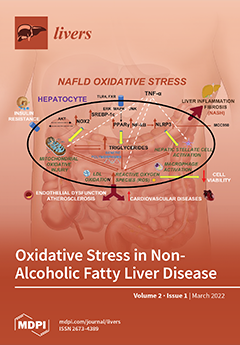Open AccessEditor’s ChoiceReview
Oxidative Stress in Non-Alcoholic Fatty Liver Disease
by
Carlo Smirne, Eleonora Croce, Davide Di Benedetto, Vincenzo Cantaluppi, Cristoforo Comi, Pier Paolo Sainaghi, Rosalba Minisini, Elena Grossini and Mario Pirisi
Cited by 66 | Viewed by 18067
Abstract
Non-alcoholic fatty liver disease (NAFLD) is a challenging disease caused by multiple factors, which may partly explain why it still remains an orphan of adequate therapies. This review highlights the interaction between oxidative stress (OS) and disturbed lipid metabolism. Several reactive oxygen species
[...] Read more.
Non-alcoholic fatty liver disease (NAFLD) is a challenging disease caused by multiple factors, which may partly explain why it still remains an orphan of adequate therapies. This review highlights the interaction between oxidative stress (OS) and disturbed lipid metabolism. Several reactive oxygen species generators, including those produced in the gastrointestinal tract, contribute to the lipotoxic hepatic (and extrahepatic) damage by fatty acids and a great variety of their biologically active metabolites in a “multiple parallel-hit model”. This leads to inflammation and fibrogenesis and contributes to NAFLD progression. The alterations of the oxidant/antioxidant balance affect also metabolism-related organelles, leading to lipid peroxidation, mitochondrial dysfunction, and endoplasmic reticulum stress. This OS-induced damage is at least partially counteracted by the physiological antioxidant response. Therefore, modulation of this defense system emerges as an interesting target to prevent NAFLD development and progression. For instance, probiotics, prebiotics, diet, and fecal microbiota transplantation represent new therapeutic approaches targeting the gut microbiota dysbiosis. The OS and its counter-regulation are under the influence of individual genetic and epigenetic factors as well. In the near future, precision medicine taking into consideration genetic or environmental epigenetic risk factors, coupled with new OS biomarkers, will likely assist in noninvasive diagnosis and monitoring of NAFLD progression and in further personalizing treatments.
Full article
►▼
Show Figures





